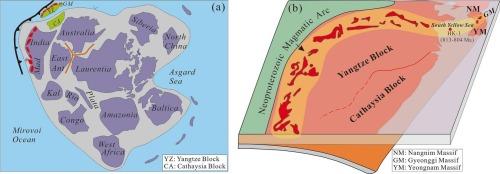Evidence for arc-related extension on the periphery of Rodinia: First report of Neoproterozoic magmatism in the South Yellow Sea, China
IF 7.2
1区 地球科学
Q1 GEOSCIENCES, MULTIDISCIPLINARY
引用次数: 0
Abstract
Understanding the dynamic linkage of Neoproterozoic extension-related magmatism between the Yangtze Block and the Gyeonggi Massif in central Korean Peninsula is crucial for reconstructing the paleogeographic evolution of East Asia during the breakup of Rodinia. The South Yellow Sea Basin, positioned between these regions, provides a key window for addressing these questions. This study systematically investigates newly discovered Neoproterozoic granites from the South Yellow Sea, integrating geochronological, geochemical, and isotopic data with published records from the Yangtze Block and the Gyeonggi Massif to decipher the origins and tectonic implications of Neoproterozoic extension-related magmatism within these blocks. The basement granites from the South Yellow Sea, dated to ca. 813–804 Ma, exhibit geochemical characteristics typical of A2-type granites and are coeval with ca. 830–790 Ma A2-type granitic magmatism in the Yangtze Block and Gyeonggi Massif. Geochemical and isotopic evidence suggests that most A2-type granites in these regions originated from the partial melting of Paleoproterozoic metasedimentary rocks, with minor crust-mantle interaction and significant fractional crystallization. Some A2-type granites in the Gyeonggi Massif, however, were derived from the melting of Paleoproterozoic mafic lower crust. These findings indicate that the ca. 830–790 Ma A2-type granitic magmatism was closely associated with continent arc extension, likely triggered by slab rollback. The South Yellow Sea and Gyeonggi Massif likely represent the eastern extension of the Yangtze Block, forming part of a marginal arc system along the periphery of Rodinia. This study provides new insights into the Neoproterozoic magmatic-tectonic evolution of East Asia and its paleogeographic configuration during the breakup of Rodinia.

罗迪尼亚周缘与弧相关伸展的证据:中国南黄海新元古代岩浆活动首次报道
了解朝鲜半岛中部扬子地块与京畿地块之间新元古代伸展性岩浆活动的动力学联系,对于重建罗迪尼亚分裂时期东亚古地理演化具有重要意义。位于这些区域之间的南黄海盆地为解决这些问题提供了一个关键窗口。本文系统研究了南黄海新发现的新元古代花岗岩,结合已有的扬子地块和京畿地块的年代学、地球化学和同位素资料,揭示了这些地块内新元古代伸展性岩浆活动的成因及其构造意义。南黄海基底花岗岩年龄约813 ~ 804 Ma,具有典型的a2型花岗岩地球化学特征,与约830 ~ 790 Ma的扬子地块和京畿地块a2型花岗岩岩浆活动同期形成。地球化学和同位素证据表明,该地区大部分a2型花岗岩起源于古元古代变质沉积岩的部分熔融作用,壳幔相互作用较小,分馏结晶作用明显。而京畿地块部分a2型花岗岩则是由古元古代基性下地壳熔融作用形成的。这些发现表明,约830 ~ 790 Ma的a2型花岗质岩浆活动与大陆弧伸展密切相关,可能是由板块回退引发的。南黄海和京畿地块可能代表了扬子地块的东部延伸,形成了沿罗迪尼亚外围的边缘弧形体系的一部分。该研究为东亚新元古代岩浆构造演化及其罗迪尼亚分裂时期的古地理构型提供了新的认识。
本文章由计算机程序翻译,如有差异,请以英文原文为准。
求助全文
约1分钟内获得全文
求助全文
来源期刊

Gondwana Research
地学-地球科学综合
CiteScore
12.90
自引率
6.60%
发文量
298
审稿时长
65 days
期刊介绍:
Gondwana Research (GR) is an International Journal aimed to promote high quality research publications on all topics related to solid Earth, particularly with reference to the origin and evolution of continents, continental assemblies and their resources. GR is an "all earth science" journal with no restrictions on geological time, terrane or theme and covers a wide spectrum of topics in geosciences such as geology, geomorphology, palaeontology, structure, petrology, geochemistry, stable isotopes, geochronology, economic geology, exploration geology, engineering geology, geophysics, and environmental geology among other themes, and provides an appropriate forum to integrate studies from different disciplines and different terrains. In addition to regular articles and thematic issues, the journal invites high profile state-of-the-art reviews on thrust area topics for its column, ''GR FOCUS''. Focus articles include short biographies and photographs of the authors. Short articles (within ten printed pages) for rapid publication reporting important discoveries or innovative models of global interest will be considered under the category ''GR LETTERS''.
 求助内容:
求助内容: 应助结果提醒方式:
应助结果提醒方式:


